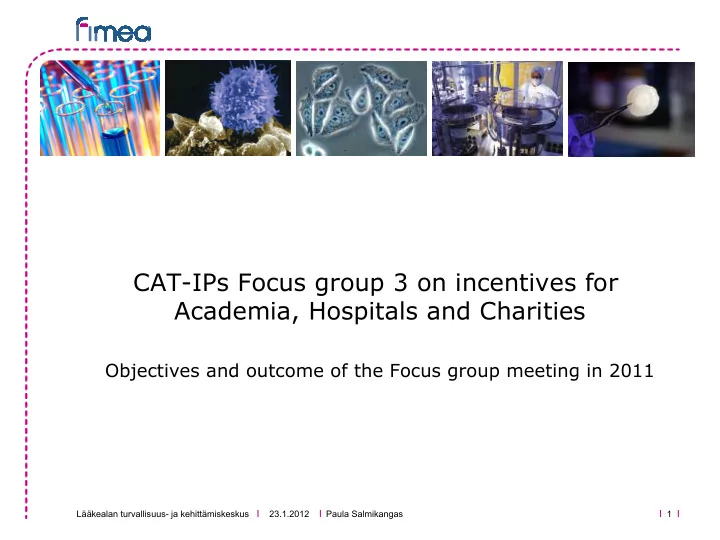

CAT-IPs Focus group 3 on incentives for Academia, Hospitals and Charities Objectives and outcome of the Focus group meeting in 2011 Lääkealan turvallisuus- ja kehittämiskeskus 23.1.2012 Paula Salmikangas 1
- objective of the meeting was to discuss available incentives and those identified important for these IPs, but currently not extended to them -meeting took place on 15th September, 2011, with participants from CAT, EMA (QoM sector, ITF office, SME office), Clinigene, EATRIS, Genethon, ISCT and Telethon -Agenda included: Introduction of CAT workplan and the IP focus groups Presentation on how to improve the system by which developers can navigate the maze of ATMPs guidance documents Discussion on the needs for guidance & incentives and current main obstacles of ATMP development and where CAT could facilitate the situation Lääkealan turvallisuus- ja kehittämiskeskus 23.1.2012 Paula Salmikangas 2
Guidelines - The presentation on how to navigate the existing guidance documents raised a discussion on available guidelines for cell-based medicinal products (CBMPs) and gene therapy medicinal products (GTMPs) - In general, it was felt that more guidance for CBMPs is needed, especially concerning requirements for clinical trials. Guidance on how to release a product for clinical trial, IMPD requirements etc. was considered important - GT guidelines were proposed to be merged and CAT should check first-in-man guidelines for ATMPs. Furthermore, when the overarching guidelines for CBMPs and GTMPs are revised, a thorough evaluation of possibilities to merge e.g. guidance from reflection papers should be conducted. Lääkealan turvallisuus- ja kehittämiskeskus 23.1.2012 Paula Salmikangas 3
Incentives - research societies do not know all incentives, better communication about available incentives and their legal requirements needed - certification procedure should be made available for charities, hospitals etc. - closer interaction between academia and regulators is needed, guidelines and their understanding is important incentive to developers - harmonisation e.g. through guidelines is needed to facilitate progress from NC studies to clinical trials. Meeting between CAT and national clinical trials authorities was proposed Lääkealan turvallisuus- ja kehittämiskeskus 23.1.2012 Paula Salmikangas 4
Regulatory obstacles - A problem was foreseen in that a large number of products are in phase I studies, but still we have only one licensed product and few in pipeline. Difficulties were seen in implementing both clinical trial and ATMP legislation, as well as in translation of the findings into products - regulatory uncertainty was claimed to lead to highest standards possible, which increases costs. Furthermore, GMO legislation seems to prevent VHP from working and GMP requirements for early clinical trials are outstanding obstacles for small developers - dynamic benefit/risk evaluation into the clinical trial process, dynamic concent-model: how to implement them? - how to make funding bodies of academic studies understand about regulatory requirements? venture capitals, private investors? - first in man issues are key, preclinical studies are not giving enough information risk-based approach for first-in-man? Lääkealan turvallisuus- ja kehittämiskeskus 23.1.2012 Paula Salmikangas 5
Points for action raise the awareness of existing incentives (e.g. in scientific meetings) to academia, hospitals and charities further harmonisation of requirements for early clinical trials, especially for orphan drugs, need for further guidelines (CBMPs) arrange a meeting between CAT and national authorities responsible of clinical trial approvals merge guidelines, make them more user friendly contact and communication with funding bodies to raise awareness of regulatory requirements in relation to grant approval address means to reduce financial risks, enhance the use of EMA procedures (certification, scientific advice, ITF) deliver messages to Commission concerning - availability of certification also to other developers than SMEs - GMP requirements of early clinical trials, GMO / VHP conflict Lääkealan turvallisuus- ja kehittämiskeskus 23.1.2012 Paula Salmikangas 6
scientific societies should contact CAT, if they wish to have regulatory/scientific training from EMA/CAT as part of annual meetings Lääkealan turvallisuus- ja kehittämiskeskus 23.1.2012 Paula Salmikangas 7
Thank you for your attention! Lääkealan turvallisuus- ja kehittämiskeskus 23.1.2012 Paula Salmikangas 8
Recommend
More recommend